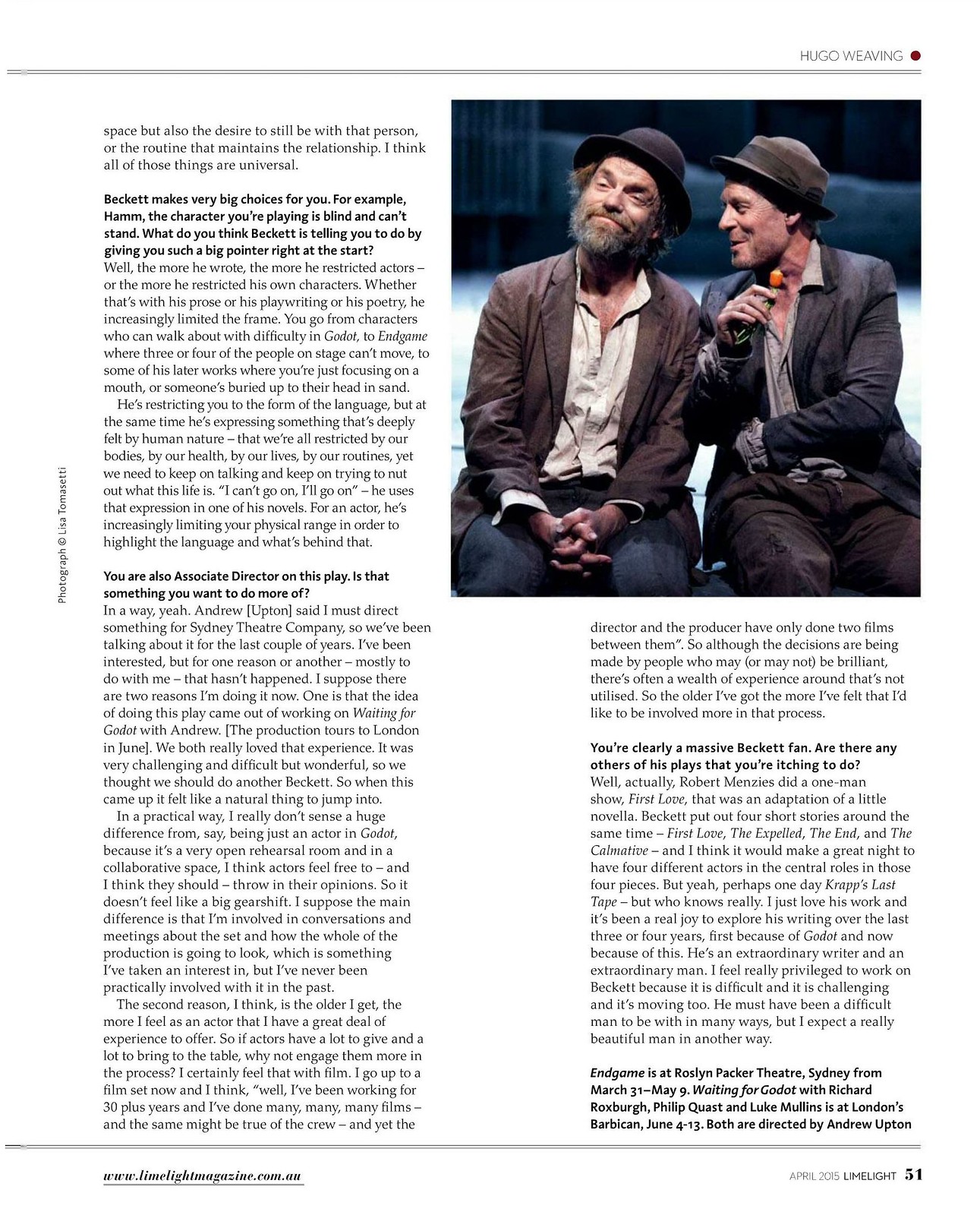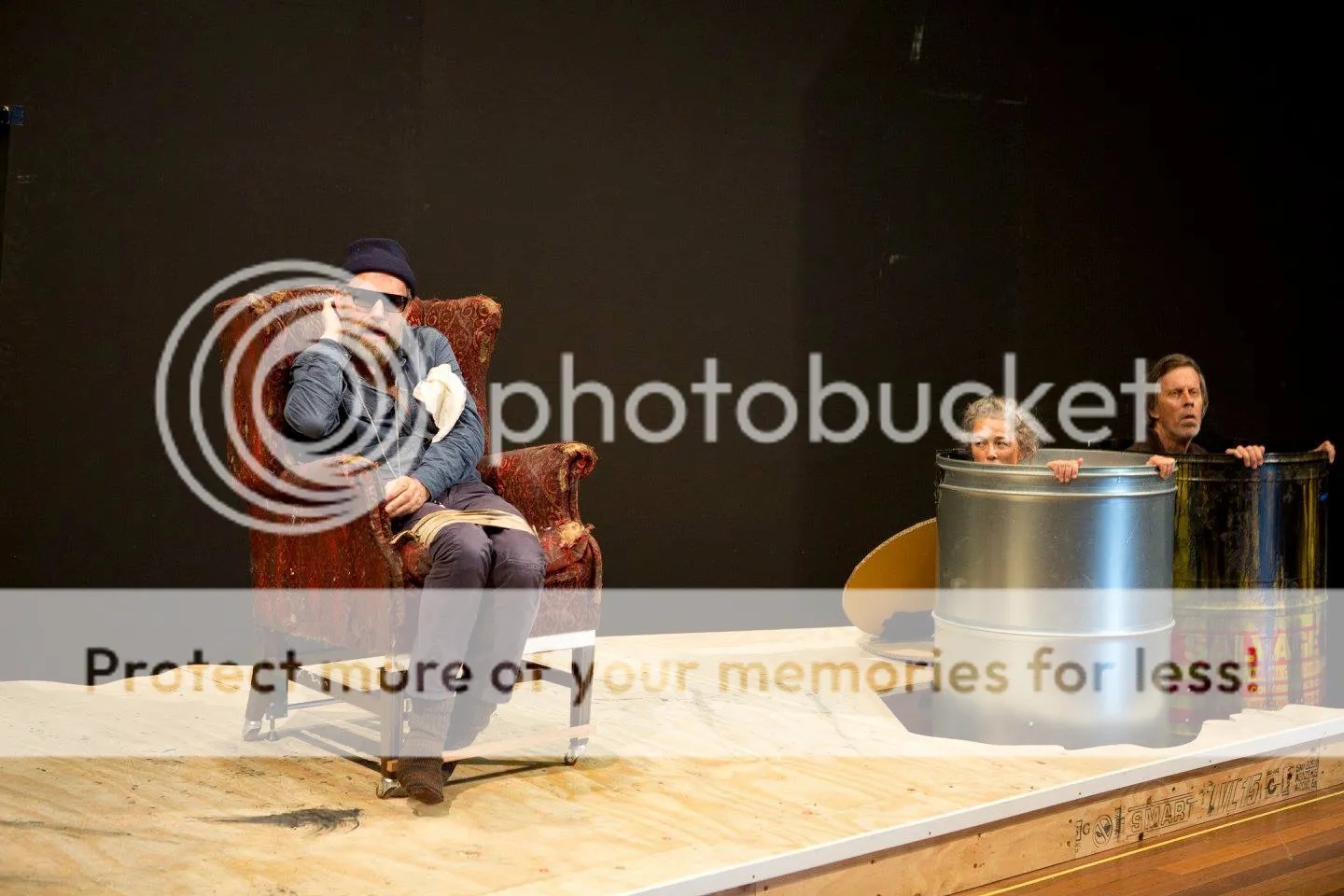
Hugo Weaving portrait by Steve Baccon, from The Australian online
Amid ongoing rehearsals for Sydney Theatre Co’s new production of Endgame, Hugo Weaving recently took time to give an interview to The Australian‘s Verity Edwards for their !0 Questions feature. The interview was published in The Weekend Australian as well as posted online. Since the online version of The Australian is very stingy about repeat page-views, I’ll post the magazine scan version, along with both versions of Steve Baccon’s delectable new portrait.

WordPress Readers: right-click, click on “Open in a new tab” for full-sized article
From The Weekend Australian magazine, 13 March 2015

Portrait by Steve Baccon, The Weekend Australian
The first question and answer are disturbing evidence that all fans learn to need how to draw boundaries, and that harassing “celebrities” on their own time (ie when not explicitly promoting a film or other project) is despicable behavior. The fact that Hugo is so generous with fans under most circumstances just makes me angrier that people continue to think the own him. Hugo’s attempts at understanding and conciliation are lovely, but he shouldn’t have to do this. I hate to bring this up, but John Lennon was similarly loving and patient with all manner of fans importuning him for autographs, often even showing up clearly…impaired at his house (one incident was documented in the 1989 film Imagine) demanding lyric explanations. Lennon would try to downplay expectation and respond with compassion.This level of openness led to a lovely number of student interviews and fan photos most artists would never permit, but it also eventually cost him his life. I know that’s a particularly scary example, but we all need to take this issue very seriously and respect our favorite actors and artists as human beings with rights, beginning with the right to a certain amount of privacy.
Shocking as it may seem, Hugo actually enjoys going to film festival TO ENJOY OTHER PEOPLE’S FILMS, not just play the star in service of his own projects. He willingly gave dozens of autographs at Sundance and posed for photos with fans, But he should be allowed to say ‘no’ without being treated abusively. That “fan” should’ve been ejected from the festival at the very least. This is one reason I don’t post videos made by professional autograph hawkers who ambush Hugo at the airport and other public places, and why I discourage people from buying autographs online. Number one, you can never be sure of their authenticity, number two, if they are authentic, they meant nothing to the person who obtained them except mere profit, and they might have been obtained in this sort of dodgy manner. Real fans have often told me they failed to meet Hugo or get one treasured item signed because these dealers crashed an event (or stage door) and Hugo had to take so much time signing their Agent Smith glossies that there was no time left for quieter, more authentic fans who were politely waiting their turn. So please, everyone– have boundaries. Be respectful.
Sorry ’bout the lecture– I know most of you don’t need it and wouldn’t dream of behaving that way. But with an artist as wonderfully unaffected and unjaded as Hugo, fans are at that much more risk of being part of the problem, even with the most sincere motives. I question my behavior and choices as an online fan every day.
The rest of the interview reaffirms most of what I’ve loved about Hugo and reassures me his commitment to serious, challenging roles remains firm.
Hugo’s new costar Tom Budge gave his own intriguing interview to the Sydney Theatre Co Magazine. He’s already had quite an eventful career, and describes the challenges of stepping into the role of Clov last-minute, his previous career highs, and the unique thrill of working with both Hugo and his son Harry Greenwood (in Gallipoli) in the same year. Here are a few quotes, but the full piece is very much worth a look– even has some STC Endgame rehearsal photos as an additional incentive.
Budge: [Describing Endgame] “I met with Andrew a year ago about this show. I thought the play was brilliant, I thought I could bring my own clown version to this role, as well as it just being beautiful and written incredibly well. But then the role went to Robert Menzies and I was honoured to have even been considered – it’s one of those rare moments where you go, ‘Oh, he’ll be f***ing amazing!’ And I’d actually been talking to Julie Forsythe about Endgame – she’s doing it at MTC right now, she’s in the bin right now – and so when I got the call from STC, there was no question. I had to ask my wife, but there was no second guessing. And it’s amazing to be back in Sydney. There’s so much great passion, energy and value put on theatre in this town…
There’s so many different kinds of clown in [Endgame]. Even within the one character. I’m realising that there’s no template with this. When you read it at first, you might think there is, but when you get to the specifics of it you realise it changes every 20 seconds. The play begins with something that everyone could recognise as a kind of clown routine – moving the ladder back and forth – but then it switches into (almost) naturalism, for a moment, then I’m playing straight man to Hamm’s laugh riot. I’m still getting comfortable with the changes and it as a general form feeling OK. But there was a gross shock to begin with of not having a simple, gradual through-line of a single ‘clown’.
[Interviewer] Hugo Weaving was talking the other day about how Beckett doesn’t give actors an easy motivational bridge between moments.
Budge: Exactly, as an actor your first thought is, “Why do I start talking about this? Why do i do that?” And Hugo’s right, most of the time there is no connection. But you get this creepy feeling – and this is a bit romantic and dramatic – that Beckett’s ghost is standing over you reassuring you that it is all there. Once you get it all down and you learn everything and you’ve done it a bunch of times, you’ll be able to stand back and it’ll be clear that something that happens two-thirds of the way through might not relate to what happened immediately prior but it does relate to something that happened for a second in the first third. And so you can find a complete through-line from one moment to another moment, it’s just really complicated. It feels seriously bizarre to begin with. I don’t think Beckett is messing with the actors, even if people assume that. I think it makes perfect sense, it’s just beyond my intelligence as to how he created it. It keeps you at arms length, so it never gets too bald… That’s the genius of it. You feel that there are conscious triple meanings in each line. It’s staggering… it’s been a real joy to be allowed into something like this, into a brain like Beckett’s. It’s fascinating. It’s beyond philosophy. It’s not just rumination, it’s very personal.
[Interviewer] That’s right, Beckett’s actually embodied it. It’s not the espousing of philosophy just in language, it’s making it happen through action – the people in his plays live that philosophy.
Budge: Yes! And it is so deeply personal, these things that he’s extracting from his life and putting out there. Look, you could read his biography and then say, “Hamm and Clov are Beckett and his wife.” But, in practice, it doesn’t help you, because no one can completely zoom in on and recreate the characters from someone else’s life. So, Hugo and I have to find our own version of a relationship, which takes time. I’d never met Hugo before this, and it takes time to get through all the normal personal stuff to something else…
In this case, the initial thing was easy, because I’d weirdly just worked with Hugo’s son – the amazing, lovely Harry Greenwood – last year on Gallipoli. He’s an incredible young man, divine. And having spent time with him you just make the assumption that at least one of his parents has to be amazing. An amazing, open-minded, divine individual. So the odds are pretty good and there’s a strange kind of familiarity in that small way. Given that I had about 10 hours’ notice between getting the job and the first reading, Hugo’s the perfect person to greet you in that situation. Warm and generous…
It’s interesting, we did our lines looking at each other just now, because Hugo realised that he never really gets to look at me in the show. None of them really look at each other much. So, as actors, it’s useful to play around with both to see what we’re each doing, because the voice and the face aren’t always doing the same thing… We’ve been talking about how it’s jazz. It’s loose, things can pop up from nowhere. But, like jazz, you learn the standard before you start improvising. So, we’re still finding the standard.”
***
The Dressmaker
Jocelyn Moorhouse’s film is still in post-production heading toward an October release in Australia. Author Rosalie Ham, who has been on hand for the film and played an extra in her own fictional town, recently posted a lovely new blog entry about a certain perk of being an extra: dancing opposite a certain Sergeant Farrat, played by Hugo Weaving in the film. (Alas, no new pics yet). Here’s an excerpt:
“Sue Maslin wasn’t in my Deportment or Ballroom dancing classes at school. I would have remembered her. But she did eat in the dining room and so she does know how to dissect and eat a banana in small half-moons, like a lady. As Sergeant Farrat does in The Dressmaker…
In dancing classes Miss Rose stressed, ‘Remain light in your partners arms, do not lean on your partner. Do not lead, allow yourself to be guided.’… These instructions were alive to me as we set off for our ‘dance’ scene in a hall in Williamstown/Dungatar. We’d received the instructional DVD and like good extras, pushed back the couch and practiced together…
In the car park we joined the other practicing extras. Angela took a firm hold of Matthew’s left hand and placed his right on her hip and said, ‘Forward, forward, back, back, side-together, slide.’… Then I was gone, led away by my old school friend, Sue. She took me to set where the actors and superstars were rehearsing and deposited me in front of Sergeant Farrat. ‘This is your dance partner.’
Sergeant Farrat was kind, but aloof, and I, terrified. The music started and he took my hand. This was my moment. I must dance without fault. Sergeant Farrat looked at me, confidence in his eyes. ‘He thinks I know what I’m doing,’ I thought. In front of us, Mr and Mrs Pratt danced like they were born to it, so I just did what they did, and, I remained light in my partner’s arms, allowed myself to be led, as did Matthew, who danced all day with Angela.”
Since Hugo isn’t mentioned by name, I am drawing certain inferences here… he’s shown certain skill as a dancer in previous film roles (and..um…charity events) 😉 so I don’t think a double or stand-in was required. I’m really looking forward to the finished film, as the creative team have been so generous about keeping fans in the loop without giving too much away.

Hugo Weaving on The Dressmaker’s dance-hall set last December. Photo: Heidi Dee, via Instagram
More Endgame promo material may appear at any time, so I’ll update as frequently as I can, first at witter, then here.
For one thing, there’s this tantalizing, trailer-promising tweet from Steph Zulu:






























































